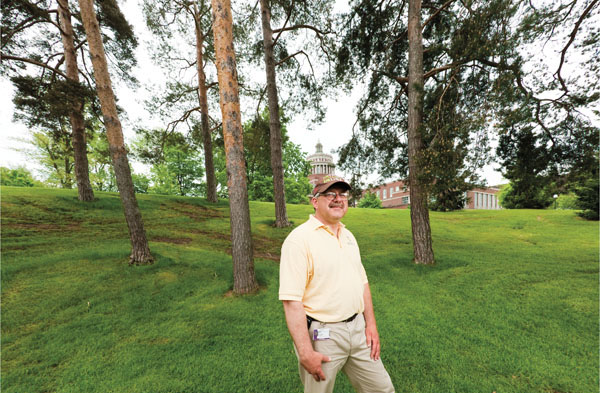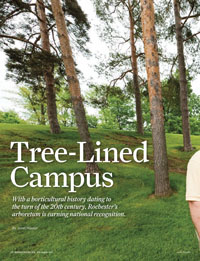Features
 ROOTED IN ROCHESTER: “[When] you realize what we have as a palette,” says Dan Schied, manager of horticulture and grounds, of the University’s arboretum, “why not look for ways to celebrate it?” (Photo: Adam Fenster)
ROOTED IN ROCHESTER: “[When] you realize what we have as a palette,” says Dan Schied, manager of horticulture and grounds, of the University’s arboretum, “why not look for ways to celebrate it?” (Photo: Adam Fenster)You might see them in late spring or early summer—one or two at a time, sometimes a larger group—stopping on the Wilson Quadrangle. The visitors pause to look at a leafy canopy that seems so well sculpted you might imagine it was dreamed up by a child who was told to draw a tree.
The goldenraintree, a hardy deciduous species originally from Asia that grows near Crosby Hall on the River Campus, is a favorite of students, who like to climb its broad branches. But horticulturists, too, have been known to stop to admire it.
“People in the know who have seen it say it’s an unusually good specimen,” says Dan Schied, the manager of horticulture and grounds at the University.
The goldenraintree may soon have new fans as the University’s arboretum earned national attention this spring when Rochester was selected to join the Arbor Day Foundation’s Tree Campus USA program. Fewer than 100 schools nationwide have earned the designation, and Rochester became just the sixth member in New York.
“It’s really quite an honor to be recognized—and a testament to the hard work of all the individuals who maintain all the campuses,” says Schied.
His 12-person team, along with support from vendors, is responsible for maintaining the University’s arboretum and grounds, which includes the trees and shrubbery on the River Campus as well as the Eastman, Medical Center, South, and Mt. Hope campuses.
To qualify as an arboretum, a collection of trees and shrubbery must have at least one person committed to its care, it must feature interpretive materials about the plants, and it must be shared at least part time with a wider community.
And sharing the history and educational information about the University’s collection, especially with students, is a favorite part of Schied’s job. “Students seem excited when you tell them their campus is an arboretum.”
As part of his work, he looks for opportunities to create collections of particular plants and plant species as a way of introducing students and visitors to the importance of landscaping and how careful consideration of plant selection and placement helps create inviting environments.
For example, he’s helped establish a collection near Meliora Hall that includes specimens of each of the Rochester-bred lilacs. Such efforts also fit into a larger horticultural legacy.
Located in a metropolitan area known as the “Flower City,” the University shares a neighborhood with Highland Park, an internationally recognized botanical garden that grew out of the Ellwanger and Barry Nursery, likely the largest nursery in the country at the turn of the 20th century. Many of the buildings—and trees—on the Mt. Hope Campus were once part of the nursery.
A presenter at national conferences on the topic of sustainability and landscaping, Schied travels frequently and says such history is rare for a college campus.
“You come back and you realize what we have as a palette,” he says. “Why not look for ways to celebrate it?”

